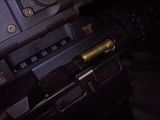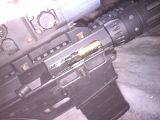The gas-port size is not determined by the platform IE: AR-10 VS. AR-15. The port size is based on the following:
1) location. Rifle-length, Mid-length, Carbine, Pistol-length or even a custom longer length.
2) Case capacity VS. bore capacity. If you take a case that holds 40 grains of powder and a .224 bore, you are going to need a smaller port than a case capacity of 26 grains and a .224 bore. Even twist-rate should be taken into account when sizing a port. In your case, a 1:8 twist barrel, you will no doubt be shooting heavier bullets with slower burning powders. That same caliber and barrel-length would need a larger port if you were using a 1:4 twist barrel, shooting light bullets and faster burning powders.
3) Barrel-length. With a given gas-system length, the port has to be slightly larger as the barrel gets shorter. In other words, if you have a rifle-length gas-system and a 24" barrel that works perfectly, when you cut that barrel back to 22", you will have to open the port slightly to get the same bolt-velocity.
4) Barrel diameter at the gas manifold. All other things being equal, a bull barrel needs a slightly larger port than a .750" manifold. The amount of distance the gas has to travel through the port does make a difference.
All that being said, I think your port is still too small. If I were going to do an educated guess, you are probably going to end up at about a #46 port (.081")
Keep in mind that when you are building your first, you really don't know "why" it isn't working. When you are working with a caliber that is new to you for the AR platform, you will need to do some trial and error on port-size. Once you have built a few, you may end up adjusting it again because of discrepancies in the parts you are using. In other words, you are working with a .22-250 with a 22" 1:8 twist barrel right now. When you have everything working perfectly, you may think that is going to be "the port size" you will be able to use on all the following builds. Not necessarily so. There are HUGE differences in all the parts in the entire gas-system. The fit of the gas-block to the barrel, the fit of the gas-block to the tube, the fit of the tube to the carrier-key, the fit of the carrier-key to the carrier, the fit of the bolt-tail to the carrier. ALL of those bits and pieces are what give you a specific bolt-velocity. When you build another, tolerances may be better, and you may find you can get by with a slightly smaller port, or you my find the exact opposite. Once you have established a final port size, then when you have short-stroking issues, you know you are having tolerance issues in other areas of your gas-system.






